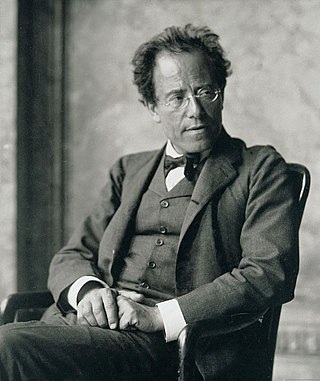External links
- A Song of Autumn : Scores at the International Music Score Library Project
- Seven Lieder (Elgar) : Scores at the International Music Score Library Project
"A Song of Autumn" is a poem by Adam Lindsay Gordon set to music by Edward Elgar in 1892.
The song was dedicated by Elgar to 'Miss Marshall'. [1] It was first published by Orsborn & Tuckwood, then by Ascherberg in 1892 before it was re-published in 1907 as one of the Seven Lieder , with English and German words (German words by Edward Sachs).
A Song of Autumn [2]
Where shall we go for our garlands glad
At the falling of the year,
When the burnt-up banks are yellow and sad,
When the boughs are yellow and sere?
Where are the old ones that once we had,
And where are the new ones near?
What shall we do for our garlands glad
At the falling of the year?
Child! can I tell where the garlands go?
Can I say where the lost leaves veer
On the brown-burnt banks, when the wild winds blow,
When they drift through the dead-wood drear?
Girl! When the garlands of next year glow,
You may gather again, my dear—
But I go where the last year's lost leaves go
At the falling of the year.
Herbstlied
Wo soll ich pflücken den Blumenstrauss,
Wenn der Herbst zieht in das Land,
Wenn die dürren Blätter gelb sind und kraus,
Und der Büsche Grün verschwand?
Wo sind die einst schmückten unser Haus,
Und wann sind die neuen zur Hand?
Wo soll ich pflücken den Blumenstrauss,
Wenn der Herbst zieht in das Land?
Kind! kann ich sagen wo Blumen blüh'n?
Wohin Blatt, wohin Blüte schwand?
Ob sie fielen unter der Sonne Glühn,
Ob die Winde sie streuten ins Land?
Frühling bringt Blumen für dich, mein Kind,
Pflücke sie mit der weissen Hand;
Doch ich werde ruh'n, wo die Blätter sind,
Wenn der Herbst zieht in das Land.

Das Lied von der Erde is an orchestral song cycle for two voices and orchestra written by Gustav Mahler between 1908 and 1909. Described as a symphony when published, it comprises six songs for two singers who alternate movements. Mahler specified that the two singers should be a tenor and an alto, or else a tenor and a baritone if an alto is not available.

Kindertotenlieder is a song cycle (1904) for voice and orchestra by Gustav Mahler. The words of the songs are poems by Friedrich Rückert.

An die ferne Geliebte, Op. 98, is a composition by Ludwig van Beethoven written in April 1816, setting poetry by Alois Jeitteles.
German sentence structure is the structure to which the German language adheres. German is an OV (Object-Verb) language. Additionally, German, like all west Germanic languages except English, uses V2 word order, though only in independent clauses. In dependent clauses, the finite verb is placed last.

Wirklich alles! is a live album from Christina Stürmer, released in 2005. It was recorded during a tour in Austria called Wirklich alles! during the fall of 2004, in promotion of her album Soll das wirklich alles sein.

The Symphony No. 8 "Lieder der Vergänglichkeit" by Krzysztof Penderecki is a choral symphony in twelve relatively short movements set to 19th and early 20th-century German poems. The work was completed and premiered in 2005. The symphony has an approximate duration of 35 minutes. Penderecki revised the symphony in 2007 by adding a few more poem settings and the piece has expanded to around 50 minutes. Although given the designation Symphony No. 8, it was not actually the final symphony Penderecki completed before his death in March 2020; the Sixth Symphony, begun in 2008, was not completed until 2017.

Im Frühling in G major is a Lied by Austrian composer Franz Schubert.
”Through the Long Days” is a song written by the English composer Edward Elgar in 1885 as No. 2 of his Op. 16, Three Songs. The words are from a poem by the American writer and statesman John Hay.
"Queen Mary's Song" is a song written by the English composer Edward Elgar in 1889. The words are by Tennyson, sung by Queen Mary I of England as she plays a lute in scene 2, act 5 of his 1875 play Queen Mary: A Drama.

Ingeborg Bronsart von Schellendorf was a Finland-Swedish and German composer.

Max Reger's 1915 Requiem, Op. 144b, is a late Romantic setting of Friedrich Hebbel's poem "Requiem" for alto or baritone solo, chorus and orchestra. It is Reger's last completed work for chorus and orchestra, dedicated in the autograph as Dem Andenken der im Kriege 1914/15 gefallenen deutschen Helden.

Johann Wilhelm Hill was a German pianist and composer.
Franz Schubert's best-known music for the theatre is his incidental music for Rosamunde. Less successful were his many opera and Singspiel projects. On the other hand, some of his most popular Lieder, like "Gretchen am Spinnrade," were based on texts written for the theatre.

Franz Schubert's best known song cycles, like Die schöne Müllerin and Winterreise are based on separate poems with a common theme and narrative. Other song cycles are based on consecutive excerpts of the same literary work: Schubert's "Ave Maria" is part of such a song cycle based on excerpts of the same poem, in this case by Walter Scott.
Spanisches Liederbuch is a collection of 44 Lieder by Hugo Wolf (1860–1903). They were composed between October 1889 and April 1890, and published in 1891. The words are translations into German by Emanuel Geibel (1815–84) and Paul Heyse (1830–1914) of Spanish and Portuguese poems and folk songs, published in a collection of 1852 also called Spanisches Liederbuch.